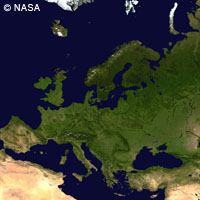The EU and media reporting - how do outlets report on the Union?
A new report, funded by the European Commission under the Sixth Framework Programme (FP6), examines the different ways that 10 European countries choose to report on the EU. The Adequate Information Management in Europe (AIM) project looked at how Belgium, Germany, Estonia, Finland, France, Ireland, Italy, Lithuania, Norway and the UK reported on the EU and its workings. The media has pf course existed in each country for far longer than the EU, but in that time, the EU's influence has grown. The report examines not just the way in which each country reports on the EU, but how the media is structured and managed in each country. To ensure consistency, only articles or broadcasts that refer to the EU explicitly were studied, and a common codebook ensured equivalence between countries. In each country, the analysis took place between 7 and 28 March 2005, which included routine reporting until the 22 and 23 March, when the European Council took place in Brussels. Three newspapers - one national, one regional and one 'popular daily', in addition to one public service and one commercial television news broadcast, were chosen from each country. Each outlet had the highest circulation or audience share in its class. The report is comprised of smaller, country-specific reports, written by experts in journalism in their country, and some common themes come through. The outlets analysed or interviewed, tended to not have dedicated EU correspondents, relying instead on a foreign desk to keep abreast of any news - even in Belgium. The EU was a frequent target of criticism for reporters. A Belgian reporter remarked that the EU's method of news management relied on 'too much communication and too little information.' Several reports suggested that stories tended to originate not from EU releases, although this did happen, but with sources placed within the EU. '[A]ll the analysed newsrooms rely on a network of personal relations or contacts with inner officials, spokespersons, and representatives through which journalists may obtain important information, whether they are in Brussels or in Italy,' reads the Italian report. More specifically, the EU is generous with its publications and communications, but information is perceived to be simply released, and not targeted sufficiently to specific regions or news desks. The UK's report suggests ways that the EU could improve its media management: ''parochialism' - local relevance, must be manifest; 'passivity' - we expect it to come to us; 'proximity' - it must seem geographically and culturally close.' Again and again, journalists cited disinterest either by editors or consumers in the EU as reasons for not giving high prominence to EU stories: 'complexity of most EU topics as well as the citizen's lack of knowledge and interest' (Belgium); 'EU issues are too abstract and irrelevant for common citizens' (Estonia); 'media consumers have little or no pre-knowledge about the EU' (Germany); the need to, 'convince editors of the newsworthiness of EU stories' (Ireland); 'scepticism on the part of media professionals as regards the media's role in creating a European public sphere or public identity' (Lithuania); 'EU news is seen to be of little salience to readers' (UK). There was less agreement on reasons for this apparent disinterest, but the outcome was the same. For example, the French study remarked that 'Periods of crisis are considered to be good news by the media outlets in the sample, whatever the characteristics. However, the EU is marked by a conspicuous scarcity of crisis.' However, for the same period, the Finnish report remarked that 'journalists assume that the status of EU news will decrease in the future. This is partly caused by the chronic political crisis within the EU, which is said to discourage the audience's interest in the EU.' Ironically, the survey was carried out during the French referendum campaign into the EU constitution. The French voted against the constitution, causing many to proclaim that the EU was in crisis. This clearly shows that the perception of the EU is by no means consistent across its Member States. Perhaps predictably, the greatest prominence was given to EU stories in national newspapers, followed by the 'popular' press, the local press and finally, television broadcasts. This hierarchy is logical - newspapers have to fill their pages. Television broadcasts do not have the luxury of space, and so the number of stories is always limited. One special case in the study was Norway - a non-EU member. The Norwegian media were pragmatic, and reported, or not, where interest or relevance demanded stories. 'They [news editors] think that their new organisations have duties to report what is going on in the world, in this case in the EU.' However, 'Combined with the conventional journalistic approach demanding drama, conflicts, and lively pictures, the effect seems to be that traditional political and economic news about the EU are marginal phenomena. Over the period, the media outlets in the countries surveyed reported a total of: Belgium - 124 items Estonia - 181 items Finland - 216 items France - 478 items Germany - 503 items Ireland - 349 items Italy - 201 items Lithuania - 314 items Norway - 219 items UK - 66 items.
Countries
Belgium, Germany, Estonia, Finland, France, Ireland, Italy, Lithuania, Norway, United Kingdom



